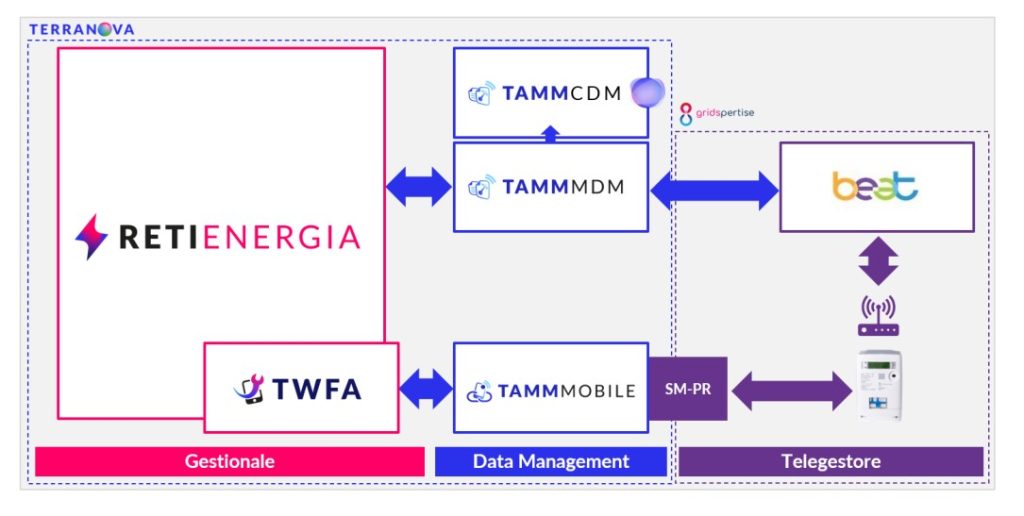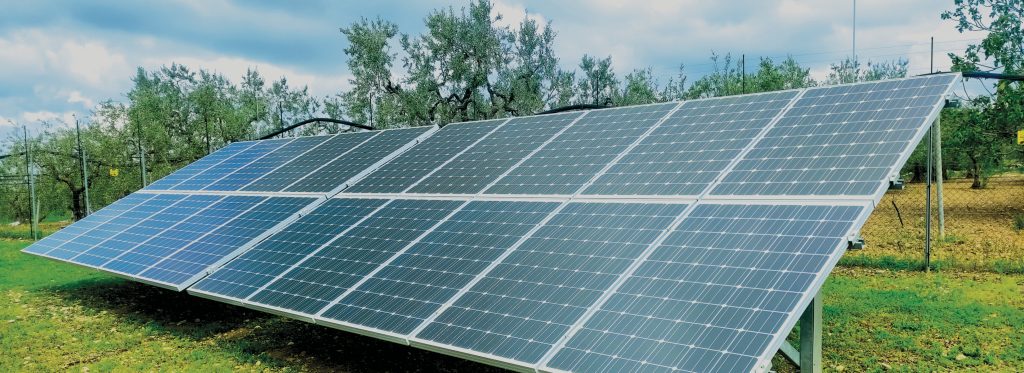
Bleiben Sie auf dem Laufenden

Ein intelligentes und automatisiertes System für Utilities/Verteiler: psaier.energies startet eine hochmoderne digitale Infrastruktur.
15. Mai – Die zweite Generation der Stromzähler markiert den Beginn einer digitalen Revolution, die das Management des Stromverbrauchs grundlegend verändert. Tägliche Ablesungen und automatisierte Systeme erleichtern nicht nur die Datenanzeige für die Nutzer, sondern auch die Verwaltung der Anschlüsse durch die Versorgungsunternehmen – immer effizienter und transparenter.
In den Jahren 2022 und 2023 hat psaier.energies strategische Vereinbarungen mit Gridspertise (einer Tochtergesellschaft der Enel-Gruppe) und mit Terranova getroffen und dabei die Software-Suite BEAT übernommen – ein fortschrittliches Werkzeug für das flexible und integrierte Management aller Prozesse der Stromverteilung.
Dank der Integration der intelligenten Stromzähler von Gridspertise mit dem System BEATSuite ist psaier.energies – mit über 20 Jahren Erfahrung in der Branche – heute in der Lage, italienischen Versorgungsunternehmen, insbesondere kleinen und mittleren Betrieben, eine vollständig digitalisierte, skalierbare und wirtschaftlich tragfähige Lösung anzubieten.
Eine vollständige AMI-Infrastruktur für lokale Netzbetreiber
Ziel ist es, die bidirektionale Kommunikation zwischen der Entnahme-/Einspeisestelle und dem zentralen Erfassungssystem des Verteilnetzbetreibers zu stärken und so ein sicheres, ferngesteuertes und automatisiertes Management zu ermöglichen.
Die Versorgungsunternehmen verfügen nun über eine nahtlos integrierte Infrastruktur, bestehend aus:
- TWO BEAT von Gridspertise: das Herzstück des AMI-Systems, zuständig für die Verwaltung, Konfiguration und Datenerfassung der intelligenten Zähler.
- TAMM/WFA von Terranova: eine KI-gestützte Engine für die Erfassung, Rekonstruktion, Validierung und Übertragung von Daten in Echtzeit an externe Systeme, darunter SII (Acquirente Unico) sowie die Abrechnungssysteme RETIENERGIA und 4SALES.

Automatisierte, zuverlässige und validierte Zählerstände
Die 2G-Zählervon Gridspertise ermöglichen automatische Ablesungen alle 15 Minuten sowie die tägliche und monatliche Übermittlung der Daten an das BEAT Suite-System. Dieses leitet die Informationen an den TAMMMDM weiter, der mithilfe einer speziellen KI-Engine (TAMMCDM) mögliche Anomalien analysiert und schätzt, bevor die Daten zur Abrechnung an RETIENERGIA übermittelt werden.
Bei Störungen oder Kommunikationsausfällen kommt das Modul TAMMMOBILE zum Einsatz, das eine Fernverwaltung des Zählers ermöglicht und so einen kontinuierlichen Betrieb, vorausschauende Diagnostik und eine deutliche Reduzierung von Vor-Ort-Einsätzen gewährleistet.
Die validierten Zählerstände werden automatisch in das Abrechnungssystem RETIENERGIA eingespeist und täglich an das Portal AU-SII übermittelt – für vollständige gesetzliche Konformität und Transparenz im Datenfluss.
Auf dem Weg zum automatisierten Meter-to-Cash-Prozess für KMU der Energiebranche
„Mit diesem Angebot ist psaier.energies eines der ersten Dienstleistungsunternehmen in Italien, da sein Projekt zur vollständigen Automatisierung des gesamten Metering-Prozessesauf den Weg bringt. Wir bieten kleinen und mittleren Versorgungsunternehmen Technologien an, die bisher aufgrund ihrer Komplexität und Kosten unzugänglich waren.“ – Eugen Psaier, CEO von psaier.energies
Mit dem vollständig digitalen AMI-Paket ermöglicht psaier.energies einen vollständigen, schnellen und automatisierten „Meter-to-Cash“-Prozess.
Energieversorger können dadurch flexible, auf Zeitfenster zugeschnittene Angebote erstellen, während Verteilnetzbetreiber Zugang zu fortschrittlichen Tools für die Überwachung und Effizienzsteigerung des Netzes erhalten.

Energy Release und Unterstützung für mittelständische Unternehmen
3. April – Psaier.energies liefert über das Energy Release Programm Energie aus erneuerbaren Quellen an mehrere energieintensive Unternehmen.
Energiepreissteigerungen haben einen sehr großen Einfluss auf energieintensive Unternehmen. Um die Preisschwankungen auf dem Energiemarkt abzufedern, können Energielieferverträge zu einem fixen Preis für einen bestimmten Zeitraum abgeschlossen werden. Für die Unternehmen bedeutet dies eine zuverlässige Belieferung mit grüner Energie und vor allem klar definierte Kosten.
Psaier.energies, ein führendes Südtiroler Energieunternehmen mit über 20 Jahren Erfahrung, hat in den letzten Monaten mehrere Projekte für das neue Energy Release Programm des GSE (Gestore dei Servizi Energetici) eingereicht. Dank der langjährigen Erfahrung in diesem Sektor, der Bereitschaft auf die Bedürfnisse eines immer dynamischeren Marktes zu reagieren und der Möglichkeit, eine umfassende „In-House“-Beratung anzubieten, werden in den nächsten Jahren mehrere Unternehmen auf nationaler Ebene mit Strom versorgt. Parallel dazu wird in neue Anlagen zur Erzeugung von Strom aus neuen erneuerbaren Energiequellen investiert.
„Unsere jahrzehntelange Präsenz im Energiesektor und unsere Fähigkeit einen Rundum-Service anzubieten, macht uns zu einem Partner der schnell und effektiv auf spezifische Bedürfnisse mit maßgeschneiderten Lösungen reagieren kann“ erklärt Eugen Psaier, CEO von psaier.energies.
Gerade diese Flexibilität, mit dem das smarte Brixner Unternehmen am Energiemarkt agiert, hat in den letzten Jahren zur Realisierung zahlreicher maßgeschneiderter Lösungen mit dem immer beliebter werdenden Instrument des Power Purchase Agreements (PPA) geführt. Diese Art von Verträgen, auch PPA genannt, sind eine hervorragende Lösung für alle Unternehmen mit hohem Energieverbrauch, die ihre Energiekosten optimal steuern wollen: Es werden maßgeschneiderte Strategien für die zukünftige Stromlieferung zu vorher festgelegten Preisen angeboten. Die Gewissheit, mit festen Preisen und einem maßgeschneiderten Angebot rechnen zu können, ist ein großer Vorteil.
Seit 2023 nutzt auch BRIMI – Milchhof Brixen das Know-how von psaier.energies um, im Rahmen eines PPA-Vertrages „grünen“ Strom zu beziehen. „Erfahrung, Dynamik und Professionalität! Diese Eigenschaften zeichnen psaier.energies aus und haben zum Aufbau einer Partnerschaft beigetragen, die nun erfolgreich in ihr drittes Jahr geht. Im Einklang mit den Werten von Brimi liefert psaier.energies jeden Tag zertifizierte Energie aus erneuerbaren Quellen“, so Martin Mair, CEO von BRIMI.
Die positiven Faktoren des PPA-Angebots von psaier.energies beschränken sich nicht nur auf den wirtschaftlichen Aspekt: Die Gestaltung dieser Verträge garantiert auch ein konkretes Engagement für Nachhaltigkeit. In diesem Sinne ist psaier.energies auf der Plattform für GO-Zertifikate (Garanzia di Origine) vertreten, die die Herkunft der Energie aus erneuerbaren Quellen bestätigen, und kann im Allgemeinen eine direkte Versorgung aus erneuerbaren Energiequellen (FER) anbieten.
Hier mehr Informationen zur grünen Energieversorgung für mittelständische Unternehmen.
